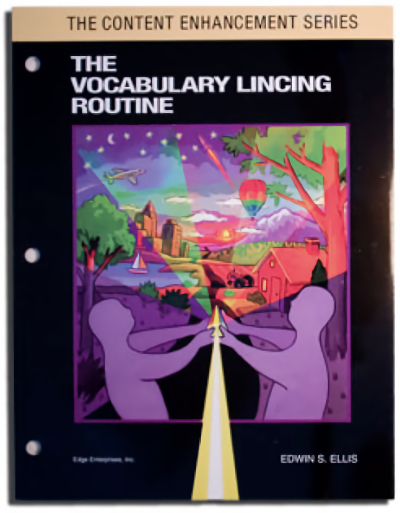The Vocabulary LINCing Routine

Teachers use the Vocabulary LINCing Routine to facilitate student use of two powerful tools (an auditory memory device and a visual memory device) to help them learn and remember the meaning of complex terms.
Among both students with and without LD, students whose teachers used the Vocabulary LINCing Routine had significantly higher overall vocabulary test scores than when their teacher had not used the routine. Students improved their performance by 19% in a study with students in grade 9.
Associated SIM Mnemonics: LINCS - learn and remember the meaning of complex terms
Author(s):Edwin S. Ellis
Publication & Purchasing Info: University of Kansas, Center for Research on Learning
KU CRL Online Store
The Story Behind the LINCS Vocabulary Routine from author Ed Ellis:
One of the things effective learning strategy teachers do is work very hard at promoting transfer and generalization of a strategy by students to other classes and settings. In other words, they want students not only to learn an effective/efficient strategy, they want the students to put the strategy to work in a range of situations and settings in ways that pay off for students. As a resource teacher, one of the things I would do to promote generalization of a strategy my students had learned was to be a “guest teacher” in my students’ general education classes and teach strategy lessons to all of the students in those classes. I would typically do this after my students had already mastered the strategy in my resource classroom. Thus, when I was teaching the general education students how to use the LINCS Strategy, for example, my students in those classrooms were often the only ones who already knew how to perform the strategy and could demonstrate their abilities to others. Obviously, this was very motivational for my students, but another objective was to make the general education teachers aware of the strategy my students had been learning and how it worked so that they could continue to promote its use in the classroom when I was not around.
What I learned while doing these “guest teacher” presentations was that most of the typical learners could readily acquire the LINCS Strategy, but students who were struggling to learn tended to need more intensive and extensive instruction in it for them to know how to perform it well enough to use it independently. I also learned that even when I did not provide the intensive strategy instruction to my students, they still benefited greatly when general education teachers embedded their subject-area instruction with activities that involved creating LINCS devices for the new vocabulary. From this knowledge sprang the LINCing Routine.
Author's Thoughts about Content Enhancement Instruction:
Don Deshler helped me understand that the way to support inclusion and provide real access to the general education curriculum for students with disabilities was to enable subject-area teachers to use “robust” instructional techniques – that is, instructional routines powerful enough to really impact the learning of students who struggle to learn complex information while also being very effective for all other students in general education classes. Research on the effectiveness of the LINCing Routine shows that it clearly qualifies as one of those robust instructional routines. Furthermore, just as the LINCS Strategy proved to be a good strategy to teach when introducing students to learning strategies, so too has the LINCing Routine been a good introduction to the concept of Content Enhancement for subject-area teachers.
Teacher Feedback on the LINCS Vocabulary Routine:
Subject-area teachers have indicated to me that the LINCing Routine is easy to learn, is easy to embed into their current instructional practices, and does not rob them of instructional time. Perhaps most importantly, teachers are very pleased when they immediately experience what Content Enhancement is all about as their students’ performance on classroom tests suddenly and dramatically improves. These experiences help subject-area teachers become much more invested in learning and using other Content Enhancement Routines that are more complex and demanding of their pedagogical knowledge, skills, planning time, and energy but that are also very effective and important to use.
This manual is available through the KU CRL Shop.
Please note that professional development, coaching, and infrastructure support are essential components to effective implementation of SIM instructional tools and interventions. It is highly recommended that you work with a SIM professional developer. See the SIM Event list for sessions or email simpd@ku.edu to learn more.
An accessible version of the documents on this site will be made available upon request. Please contact the KU CRL Professional Development Research Institute, at simpd@ku.edu to request the document be made available in an accessible format.